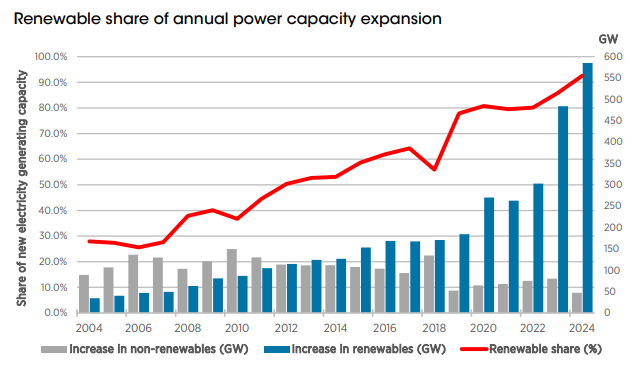92.5% of New Power Capacity Additions Globally in 2024 was Renewables: Report
Solar power accounted for the largest share in the capacity additions
March 28, 2025
Follow Mercom India on WhatsApp for exclusive updates on clean energy news and insights
Global renewable energy capacity additions totaled 585 GW in 2024, a record 15.1% growth year-over-year, the highest annual increase since 2000. Renewable energy represented 92.5% of the new power capacity additions globally, according to the latest report from the International Renewable Energy Agency (IRENA).
Solar and wind energy continued to dominate, jointly contributing 96.6% of the net renewable energy capacity additions in 2024.
Global renewable power capacity reached 4,448 GW at the end of 2024. Solar comprised the largest share of renewable energy capacity, with 1,865 GW, followed by hydropower at 1,283 GW and wind energy at 1,133 GW.
A majority (72%) of the new renewable capacity added in 2024 was in Asia, with 421.5 GW to reach a total of 2,382 GW (53.6% of the global total). China contributed the most, with 373.6 GW. In 2024, Europe’s capacity expanded by 70.1 GW, with Germany adding more than 18.8 GW.
North America expanded by 45.9 GW, driven by installations in the United States. Africa added 4.2 GW and Oceania 8.7 GW. The Middle East recorded a 3.3 GW increase in new capacity in 2024, with Saudi Arabia accounting for more than half of the total expansion.
The share of renewables in new power capacity expansion in 2024 was 92.5%, compared to 85.8% in 2023. The renewable share in the total installed power capacity globally rose from 43.1% in 2023 to 46.4% in 2024.
Solar
Over three-quarters of the renewable energy capacity added in 2024 was solar, with 452 GW, a 32.2% growth year-over-year (YoY).
Asia contributed to most of the solar capacity additions, with 327.1 GW added in 2024, a 32% YoY increase. The largest capacity installed was in China (278 GW). Outside Asia, the United States added 38.3 GW of solar capacity in 2024, a 54% YoY growth. Brazil added 15.2 GW and Germany 15.1 GW.
Wind
In 2024, wind energy installations totaled 113 GW, an 11.1% increase YoY. China led the expansion by adding more than two-thirds of the total capacity, with 79.9 GW. United States installed 5.1 GW. Other countries with significant capacity growth included Brazil, India, Canada, Türkiye, and several other European countries.
Francesco La Camera, Director-General of IRENA, said, “The continuous growth of renewables we witness each year is evidence that renewables are economically viable and readily deployable. Each year, they keep breaking their own expansion records, but we also face the same challenges of great regional disparities and the ticking clock as the 2030 deadline is imminent.”

2030 Target
According to the report, despite a sharp increase in global capacity, the growth still falls short of the required rate to achieve the global installed renewable power capacity target of over 11 TW by 2030.
Maintaining the growth rate (15.1%) observed in 2024 would yield only 10.4 TW of renewables by 2030, falling 0.8 TW (7.2%) short of the target.
Between 2018 and 2023, the global renewable energy capacity expanded at a compound annual growth rate of 10.4%. If this trend continues, 8 TW of installed renewable capacity is expected by 2030, but it will still fall short of the target by 3.1 TW (27.9%).
Achieving the 2030 target would require maintaining a minimum annual growth rate of 16.1% from 2024 onwards.

In 2024, IRENA released a report stating that the world must achieve a minimum annual growth rate of 16.4% in renewable energy installations to triple capacity by 2030, a target set at COP28 in the United Arab Emirates.
In another report, the agency stated that renewable energy costs have decreased in 2023, making clean energy sources more economically viable than fossil fuels.
